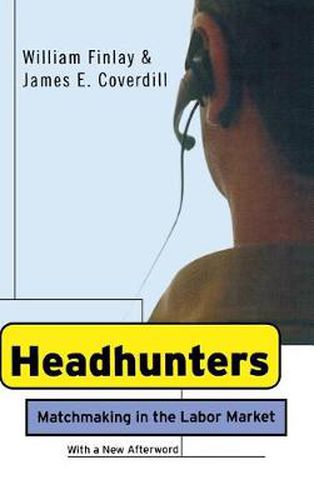Readings Newsletter
Become a Readings Member to make your shopping experience even easier.
Sign in or sign up for free!
You’re not far away from qualifying for FREE standard shipping within Australia
You’ve qualified for FREE standard shipping within Australia
The cart is loading…






Headhunters are third-party agents paid a fee by companies for locating job candidates perform a unique sales role. The product they sell is people, matching candidates with jobs and companies with candidates. Headhunters affect the professional lives of thousands of employees every day, and their work has a profound, though hidden, effect on the employment picture in the United States. William Finlay and James E. Coverdill draw on interviews with and observations of headhunters and on analysis of headhunting training seminars, lectures, industry newsletters, and a mail survey of headhunting firms. The result is a frank and sometimes unsettling portrait of the aims, attitudes, and tactics of practitioners.
The payment of fees has shifted from candidates to employers, and recruiters now find people to fit jobs rather than the other way around. Finlay and Coverdill address what they feel is a serious lack of research about the work headhunters do and how they do it. Their book is built around three major questions: What advantages do employers derive from using third-party agents to handle candidate search and recruitment? How are headhunters able to accomplish the double sale (‘selling’ candidates to employers and employers to candidates)? What criteria do headhunters use for selecting candidates? In the process, Finlay and Coverdill link their findings to larger issues of institutional and historical context, revealing the economic and political reasons clients use headhunters, demonstrating how headhunters manipulate clients and candidates, and assessing the impact of headhunters’ actions on hiring decisions.
$9.00 standard shipping within Australia
FREE standard shipping within Australia for orders over $100.00
Express & International shipping calculated at checkout
Headhunters are third-party agents paid a fee by companies for locating job candidates perform a unique sales role. The product they sell is people, matching candidates with jobs and companies with candidates. Headhunters affect the professional lives of thousands of employees every day, and their work has a profound, though hidden, effect on the employment picture in the United States. William Finlay and James E. Coverdill draw on interviews with and observations of headhunters and on analysis of headhunting training seminars, lectures, industry newsletters, and a mail survey of headhunting firms. The result is a frank and sometimes unsettling portrait of the aims, attitudes, and tactics of practitioners.
The payment of fees has shifted from candidates to employers, and recruiters now find people to fit jobs rather than the other way around. Finlay and Coverdill address what they feel is a serious lack of research about the work headhunters do and how they do it. Their book is built around three major questions: What advantages do employers derive from using third-party agents to handle candidate search and recruitment? How are headhunters able to accomplish the double sale (‘selling’ candidates to employers and employers to candidates)? What criteria do headhunters use for selecting candidates? In the process, Finlay and Coverdill link their findings to larger issues of institutional and historical context, revealing the economic and political reasons clients use headhunters, demonstrating how headhunters manipulate clients and candidates, and assessing the impact of headhunters’ actions on hiring decisions.